“Persevere and perfect detail work. Think out your designs and trust your gut.” These are the words of advice Todd D’Agostino would give a budding luthier today. Though he might sound like a 40-year veteran of guitar building, it wasn’t that long ago the luthier was doing something else altogether.
As an electrician in New England, D’Agostino grew tired of the cycle of getting laid off and rehired in a wildly fluctuating construction industry. He wanted something stable that would keep him busy 40 hours a week, year-round, and something inside so he’d no longer have to deal with the “wicked cold” winters in the Northeast.
In 2000, D’Agostino was perusing a local periodical when he came across a job posting that read, “Like Guitars? Like to Work with Wood?” He’d played the guitar since age 10, and was mechanically inclined with his hands, so the opportunity certainly sounded interesting. After interviewing for the open position with Hamer Guitars in New Hartford, Connecticut, D’Agostino was hired by (PG columnist) Jol Dantzig to join the crew.
Though he didn’t set out to be a luthier, D’Agostino believes it was a calling of sorts and he quickly caught the guitar-builder bug. It was only a year later that he started LaRose Guitars as a side project while still working at Hamer. “I laid down my roots the first two years and my interest in the craft went through the roof,” says D’Agostino. “I’d come home from Hamer and research, seek out vendors, buy woods, and build. I recollect routing some of my first guitars in the hallway of my small one-bedroom loft apartment—it took weeks to get the dust cleaned up!” Adds D’Agostino, “The point is that I couldn’t not build. I was a bit out of control in a great way.”
D’Agostino left Hamer in 2005 to build on his own in the shop he opened in Farmington, Connecticut, and then later moved the operation to Tyler, Texas, in 2008. Since then, he’s been running LaRose Guitars out of Tyler where he handles all the building, finishing, and the business logistics, while managing a staff of three others who assist with research and development, electronics, and setups. The luthier currently offers six base models, all boasting inspiration from the classic designs of the past century while incorporating D’Agostino’s ideas and the invaluable experience he acquired while apprenticing at Hamer. “Jol Dantzig and Michael Shishkov shared a world of knowledge and skill that truly helped fuel my desire to branch out on my own,” says D’Agostino.
Like most luthiers, D’Agostino has a serious passion for beautiful woods. “I find great satisfaction in discovering an amazing piece and imagining the instrument I could create out of it.” He offers a number of wood options, but his favorites to work with are Brazilian rosewood, Madagascar rosewood, white limba, and curly movingui.
When it comes to electronics, D’Agostino is a champion for a particular pickup company although other pickups can be and do get requested. “Lollar is the standard,” he says. “You just can’t go wrong with them. When working with the quality of woods I work with, Lollars just let the wood sing and allow the true voice of our instruments to be heard.”
After two years of research and development to find a chambering design, neck, and electronic placement that would create a unique voice all its own, the 1 Ton Hollow Boy is the model D’Agostino considers to be his signature. But the luthier approaches all of his instruments uniquely. “Tonally, they have characteristics that we’re used to, but that surpass and stand alone in the sonic spectrum,” he says. “And aesthetically, they have a familiar yet different look, but not too far from the norm—just enough to make you say, ‘wow.’”
Pricing and Availability
LaRose Guitars builds approximately 50
guitars annually, with plans for expansion.
Direct sales make up about 95 percent of
orders, the dealers order for customers on
occasion. The wait time for both custom
and standard models is currently five to
six months. Prices range from $2,500
to $8,000, with most models falling in
between $4,000 to $6,000.
larose-guitars.com
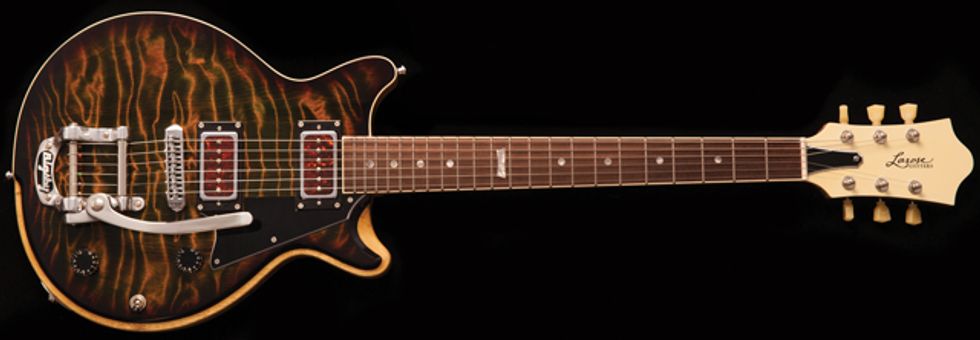
Classic 6 Jr. DC
This 25"-scale Classic 6 Jr. DC features a
double-cutaway body carved from white limba
that’s topped with highly figured curly redwood.
Also using the optional white limba for the neck,
it’s capped with a Brazilian rosewood fretboard
adorned with mother-of-pearl inlay work. Other
appointments include the ivoroid headstock
veneer, ivoroid body binding, and the Bigsby
B5 vibrato. For electronics, this Classic 6 Jr. DC
is outfitted with tortoise-inlaid Lollars, with an
SCFH in the bridge and a 5-percent underwound
SCFH in the neck.

Classic 6 Jr. SC
The SC version of D’Agostino’s Classic 6 Jr.
model comes standard with a curly maple top
but is shown here with gorgeous, quilted sapele
atop a white limba body. Loaded up with a pair
of optional Lollar P-90 pickups, other options on
this particular SC include the ebony fretboard,
white limba neck, gold hardware, neck and
headstock binding, and a Bigsby B5.
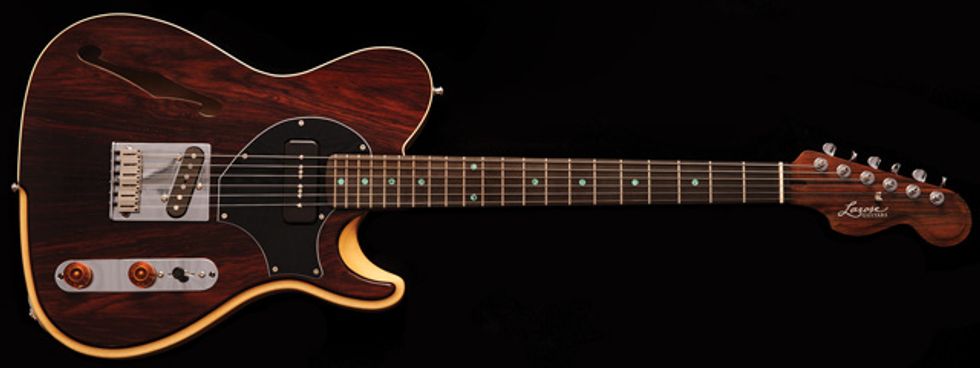
1 Ton Hollow Boy
It’s easy to see why D’Agostino calls the 1 Ton
Hollow Boy his signature model. This ’Boy
boasts an optional Brazilian rosewood top on a
hollow, white limba body, and features Brazilian
for the neck and fretboard, which is adorned
with turquoise marker dots. With a Lollar
J-Street single-coil resting in the Joe Barden
vintage-style bridge, this 25.5"-scale classic-looking
axe is outfitted with a 5-percent underwound
Lollar P-90 in the neck position.
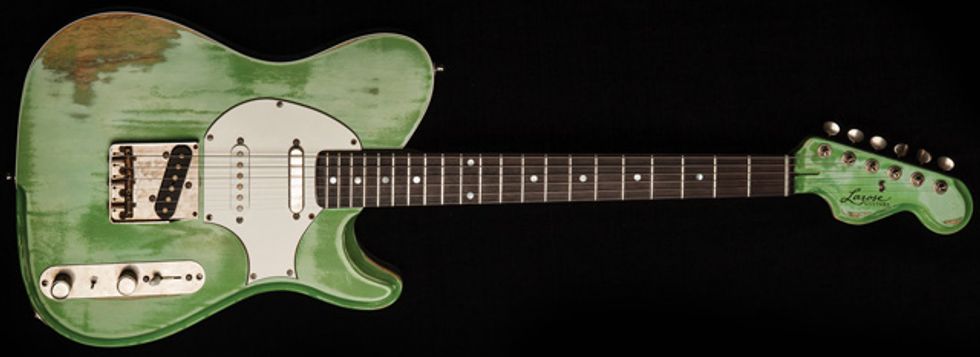
Thin 6
The distressed mint-green finish on the swamp
ash, ivoroid-bound body of this Thin 6 gives it
the look of a guitar that’s already seen its share
of action over a few decades. With matching
finish on the headstock, the rock-maple neck is
capped with a Madagascar rosewood fretboard
that’s kissed with mother-of-pearl dots. For
electronics, this Thin 6 model houses a trio of
Lollars with a Special T in the bridge, a Vintage
T in the neck and a Vintage Blonde Strat-style in
the middle position.
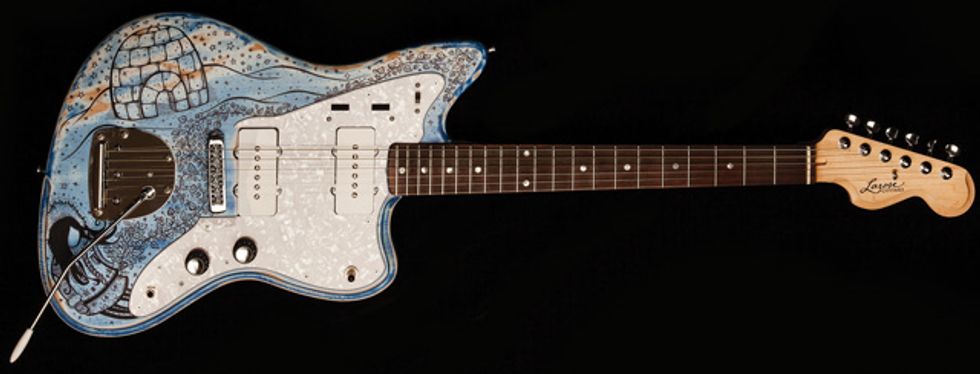
Classic Jazz
D’Agostino’s Classic Jazz is a spec-on nod to
a vintage Jazzmaster and the worn-blue-jean
distressed finish of this particular piece is
decorated with hand-drawn graphics from artist/
musician Sherri Dupree Bemis. Loaded up with
Lollar Jazzmaster-style pickups in both the neck
and bridge, other appointments on this classic-looking
machine include the roller bridge from
Schaller and TonePros Kluson tuners.
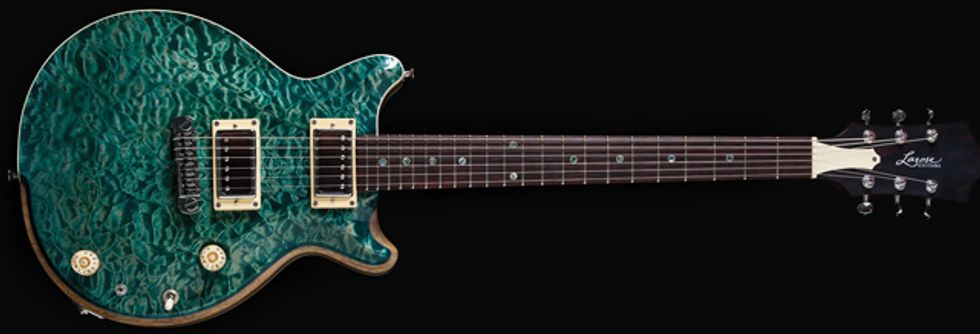
Classic 6
The Classic 6 (offered in both SC and DC versions)
is the only carved-top instrument made by
D’Agostino, and this double-cutaway Classic 6
features superior-grade quilted maple for its eye-catching
topside. The Madagascar rosewood
neck is topped with an abalone dot-adorned
fretboard carved from Brazilian rosewood. With
optional Brazilian rosewood inlay capping the
pair of Lollar humbuckers, the Classic 6 model
comes standard with an Imperial in the neck and
a High Wind Imperial in the bridge. For acoustic
tones, this Classic 6 is also outfitted with an
optional ghost piezo system from Graph Tech.













![Rig Rundown: Russian Circles’ Mike Sullivan [2025]](https://www.premierguitar.com/media-library/youtube.jpg?id=62303631&width=1245&height=700&quality=70&coordinates=0%2C0%2C0%2C0)




